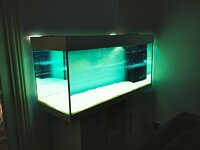RolyMo
Member
First Post..
Bit of background. As a 40th birthday present I have been given an aquarium. Ok more like I chose it with a limit in mind. Was shooting for a biOrb until I compared what I could get if I select a more traditional shaped aquarium
First Night
Managed to un-pack and build the cabinet and put the 180l tank onto it. Every looks glossy and nice. Had to carefully read how to set up the filter etc.
Then added Tropica Plant Growth Substrate x 2 bags to give approx 1cm layer on the bottom.
Added light colour tropical tank grade sand x 2 sacks to give a further 1-2cm layer onto of the substrate.
Carefully ran a hosepipe from the outside into the house to fill up the tank to the relevant level with tap water.
Added 90ml of Tetra Water Care to dechlorinate the water.
Stood back and admired the first step in my new hobby.

Bit of background. As a 40th birthday present I have been given an aquarium. Ok more like I chose it with a limit in mind. Was shooting for a biOrb until I compared what I could get if I select a more traditional shaped aquarium
First Night
Managed to un-pack and build the cabinet and put the 180l tank onto it. Every looks glossy and nice. Had to carefully read how to set up the filter etc.
Then added Tropica Plant Growth Substrate x 2 bags to give approx 1cm layer on the bottom.
Added light colour tropical tank grade sand x 2 sacks to give a further 1-2cm layer onto of the substrate.
Carefully ran a hosepipe from the outside into the house to fill up the tank to the relevant level with tap water.
Added 90ml of Tetra Water Care to dechlorinate the water.
Stood back and admired the first step in my new hobby.





